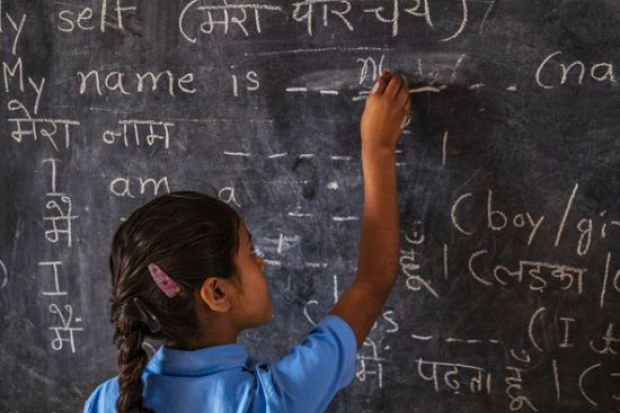Indian public universities have been advised to allow students to use local and regional languages in entrance exams – even if they teach in English – in a move by the country’s university oversight body.
Last month, India’s University Grants Commission (UGC) asked publicly funded institutions to allow students to write their university entrance exams in local and regional languages, departing from the current practice of requiring English language exams.
“The academic ecosystem continues to be English medium-centric,” wrote UGC chair M. Jagadesh Kumar in a letter to universities, adding that teaching and learning in Indian languages – a priority under the 2020 National Education Policy – had benefited students, “particularly the socially and economically disadvantaged groups”.
“The commission requests that...students in your university be allowed to write the answers in local languages in examinations even if the programme is offered in English medium,” he said.
While worded as a request, the letter is in essence an order to universities, scholars said. As such, it could potentially change how millions of learners in India’s 40 million-strong higher education system take the crucial test.
The move comes amid other attempts by New Delhi to transition away from English as India’s dominant language in government and academia. In October 2022, a parliamentary committee considered a proposal for Hindi to replace English as the language of instruction for some courses – a plan that authors said was intended to reduce the dominance of English, undo colonial-era influence and improve access to education.
Some proponents have argued that the introduction of local language exams could help increase representation by rural and lower-caste students who don’t speak English at home or in school. But critics say such plans are impractical and difficult to implement.
Debjani Sengupta, associate professor of English at the University of Delhi’s Indraprastha College for Women, said the UGC move was part of a “political and cultural push” to promote regional Indian languages by India’s ruling party to “wean away Indian society from extensive use of English”.
“The recent move by UGC, although seemingly to benefit rural and other students from marginalised backgrounds, may backfire for a variety of reasons,” she warned.
“Given the vast number of students who are and who will be taking these exams, the move seems to add a chaotic element to a situation already fraught with uncertainty.”
A top-down push, paired with “inadequate public spending on education” was not a recipe for success, she said. “Do we have qualified teachers in all disciplines who are equally versatile in their mother tongues? The answer is an obvious no.”
Another Indian academic, who requested to speak anonymously, said she was broadly supportive of the idea to give students more choice in the languages they study in, but criticised the government’s approach.
“I think it is beneficial to allow students to take entrance exams in local languages. However, stopping there will not help,” she said, adding that giving equal status to local languages should start early on.
“The support has to be increased and be done much more seriously right from the secondary level of education.”
She noted that, even at regional universities funded by Indian states, which tended to be more “sensitive” to language access issues and allow use of local languages in their teaching and exams, students faced other barriers, including a lack of study materials in these languages.
Ultimately, though, all students – including those who go through university well supported in their native tongue – would face a harsh reality when they graduated, she said: “In the job market, English is still important.”
Register to continue
Why register?
- Registration is free and only takes a moment
- Once registered, you can read 3 articles a month
- Sign up for our newsletter
Subscribe
Or subscribe for unlimited access to:
- Unlimited access to news, views, insights & reviews
- Digital editions
- Digital access to THE’s university and college rankings analysis
Already registered or a current subscriber?









